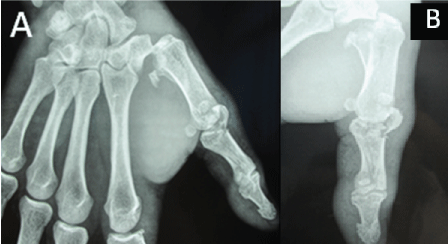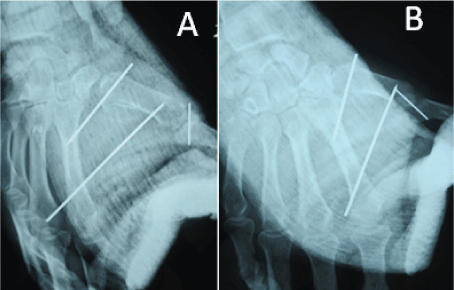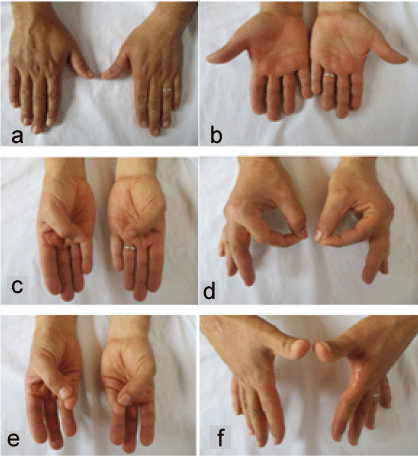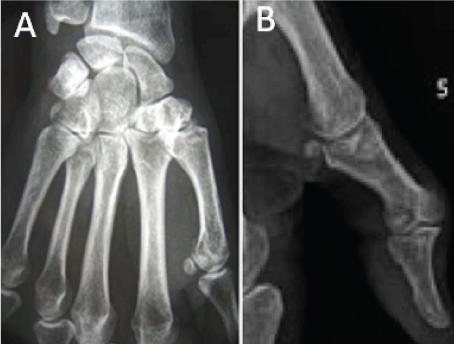Floating first metacarpal has been scarcely described in the literature. Fracture dislocation of the trapezio-metacarpal joint has been reported more than the isolated form but deemed exceptional. We report a 40-year-old man consulting for an injury on his right thumb in which the described mechanism was an axial metacarpal force with both flexed trapezio-metacarpal and interphalangeal joints. X-ray findings revealed a floating metacarpal composed from a Bennet fracture dislocation of the trapezio-metacarpal joint and a fracture dislocation of the base of the proximal phalanx. A closed reduction and percutaneous fixation was achieved. After removal of pins and physiotherapy, and at 12 months of follow up, anatomical and functional outcomes were satisfied with a normal motion of the thumb. The aim of our case report is to improve the closed reduction and percutaneous fixation on fracture dislocation of the trapezio-metacarpal on contrast to the isolated dislocation form in which closed reduction must be avoided.
Trapezio-metacarpal, Fracture, Dislocation, Bennet, Phalanx, Floating, Closed reduction, Fixation
Traumatic trapezio-metacarpal joint fracture dislocation is exceptional [1]. Several treatment options have been described; however, optimal treatment strategies are controversial [2]. In this article, we report a case of trapezio-metacarpal joint fracture dis¬locations composed from Bennet fracture and horizontal dislocation of the joint associated with a fracture of the base of the proximal phalanx of the thumb. The aim of our case report is to put into consideration the main characteristics of such entity and review the different options of treatment. The fracture dislocation was successfully treated with closed reduction and percutaneous K-wires fixation. To our knowledge, this association has never been scarcely reported reviewing the literature [3,4]. The functional and anatomical outcomes revealed that closed reduction and percutaneous fixation is available in fracture dislocation more than isolated dislocation.
We report a 40-year-old man, consulting in emergency department after a traffic road accident, complained about pain, tenderness, and swelling of his right thumb. X-ray findings revealed a horizontal dislocation of the trapezio-metacarpal joint combined to a Bennett fracture type III and a fracture of the base of the proximal phalanx of the same thumb (Figure 1). The diagnosis of floating first metacarpal is so taken. Under general anesthesia, a closed reduction of trapezio-metacarpal joint fracture dislocation and the phalange fracture was achieved under fluoroscopic control. Repeated X-ray revealed a perfect reduction of both dislocation and fractures without any incongruence in both of the two joints. The reduced dislocation was fixed by percutaneous pinning according to Iselin procedure whereas; the phalange fracture was fixed by one direct k-wire (Figure 2). The thumb was immobilized with cast for 6 weeks. Physiotherapy and rehabilitation of the thumb were started after the removal of the cast and maintained for two months. At the 12-month of follow-up, physical examination showed an unrestricted painless range of motion of the thumb: palmar abduction 70°, radial abduction 50°, complete and symmetrical opposition and retropulsion (Figure 3). Grip strength was 37 kg against 40 kg on the uninjured right side; The pinch power was 7 kg on both sides. An excellent radiological result (Figure 4) and functional outcome was noted with the patient performing normally at his job, having no limitation of his activities of daily living, and reporting no pain or instability symptoms.
 Figure 1: (A,B) X-ray views of the right hand revealing the floating metacarpal of the thumb with a fracture dislocation of the trapezio-metacarpal joint composed from an horizontal dislocation with bennet fracture and a fracture of the base of the proximal phalanx. View Figure 1
Figure 1: (A,B) X-ray views of the right hand revealing the floating metacarpal of the thumb with a fracture dislocation of the trapezio-metacarpal joint composed from an horizontal dislocation with bennet fracture and a fracture of the base of the proximal phalanx. View Figure 1
 Figure 2: (A,B) Post operative X-ray views: reduction of the dislocation and fixation according to Iselin procedure. View Figure 2
Figure 2: (A,B) Post operative X-ray views: reduction of the dislocation and fixation according to Iselin procedure. View Figure 2
 Figure 3:Functional outcome of the thumb. Motion of the trapezio-metacarpal joint and interphalangeal joint seems to be similar to the other one (A) Extension of the thumb in dorsal view; (B) Extension of the thumb in volar view; (C) Flexion of the thumb; (D) Dorsal viex of thumb opposition; (E) Volar view of thumb opposition; (F) Dorsal view of the first commissural spaces of the hands. View Figure 3
Figure 3:Functional outcome of the thumb. Motion of the trapezio-metacarpal joint and interphalangeal joint seems to be similar to the other one (A) Extension of the thumb in dorsal view; (B) Extension of the thumb in volar view; (C) Flexion of the thumb; (D) Dorsal viex of thumb opposition; (E) Volar view of thumb opposition; (F) Dorsal view of the first commissural spaces of the hands. View Figure 3
 Figure 4: (A,B) X-ray views at the final follow up showing joint congruency of the trapezio-metacarpal and interphalangeal joint.View Figure 4
Figure 4: (A,B) X-ray views at the final follow up showing joint congruency of the trapezio-metacarpal and interphalangeal joint.View Figure 4
The trapezio-metacarpal fracture-dislocation of the thumb is exceptional. It accounts for less than 1% of all hand injuries [1]. The carpometacarpal joint of the thumb is a biconcave saddle joint. The tra¬pezium is convex on anteroposterior views and concave on lateral views, however, the thumb metacarpal has the opposite views. In fact, this typical anatomical configuration allows the thumb to have a large range of motion varying from abduction to opposition while the joint remains stable [2]. Besides, the trapezio-metacarpal joint is stabilized by a thick¬ened joint capsule composed of several ligaments but stability is primarily provided by 4 main ligaments: the volar oblique, the intermetacarpal, the dorsoradial, and the posterior oblique ligament [5]. Despite the variety of biomechanical studies, no ligament has been identified to be the key stabilizer of the joint so that no ligament is identified to be the main damaged one in each kind of dislocation [6]. However, and for a long period of time, the volar oblique ligament has been believed to be the key stabilizer of the trapezio-metacarpal joint [7]. This intrinsic joint stability makes isolated trapezio-metacarpal dislocation quite rare injury. So, the fracture dislocation occurs more than the isolated form [8]. There are evidences that, in trapezio-metacarpal dislocation, the dorsoradial ligament tear, lead to a subperiosteally stripping of the volar oblique ligament deemed intact. Therefore, extension and pronation of the thumb tightens the stripped volar oblique ligament and caused dislocation of the joint associated with a partial fracture of the metacarpal base [6-9]. In fact, this anataomopathology reveals that healing the dorsolateral ligament in an appropriate position, the trapezio-metacarpal joint becomes stable [10]. Several studies have reported some mechanisms to explain this injury but two mechanisms have been adopted for a traumatic fracture-dislocation of the trapezio-metacarpal [11,12]. The first one is a longitudinally directed force along the axis of the metacarpal with a full flexion of the joint [11,12]. The second is a force driven into the first web space of the thumb. This force separates the base of the first and second metacarpal joints and pro¬duces a fracture dislocation of the trapezio-metacarpal joint [11,12]. In our case, longitudinally directed force along the axis of the metacarpal with flexion of both trapezometacarpal and interphalangeral joint is the mechanism of floating metacarpal. The treatment of this injury is controversial [13]. Several options have been reported in literature [13]. The treatment’s procedures varied from a closed reduction and immobilization to a closed or open reduction and K-wire fixation with or without the reconstruction of the capsule and ligaments [14]. It is well reported that the objective of the management of acute trapezio-metacarpal fracture-dislocations is to ensure the joint stability after reduction [15]. Open reduction is indicated after failure of the closed reduction.
We performed a closed reduction and percutaneous K-wires fixation, according to Iselin procedure [16] for the trapezio-metacarpal fracture dislocation and a direct pinning of the base in the phalange fracture. Although the extent of ligamentous injury was not determined, we believed that the volar oblique liga¬ment was intact since the avulsion of the first metacarpal base was seen. Open reduction and ligamentous repair were discussed for only the isolated dislocation of the joint since there is a total disruption of the dorsal capsule and the dorsoradial ligament [13,14,17]. Whereas, in our case, the metacarpal base and the trapezium bone remains connected by these structures. Hence, Ligament reconstruction of the inter metacarpal and capsular structures, such as an inter metacarpal abductor pollicis longus ligamentoplasty [18] which have been recommended following isolated dislocation in order to prevent post traumatic arthritis and decrease the progression of the degenerative process seem no mandatory in fracture dislocation of the joint and deemed only available in isolated dislocation [19]. In our case report, and at the 12-months of follow-up, the patient showed a normal range of motion, normal strength and no joint instability. Overall, he was satisfied with the outcome. The aim of our case report is to remember that closed reduction and percutaneous pinning on fracture dislocation in trapezio-metacarpal joint deemed an available treatment option. Reparation of ligament and capsular damages is relevant step since the radio dorsal ligament and dorsal capsule are intact.
Floating metacarpal thumb has been scarcely described to our knowledge. The mechanism of injury is similar to the isolated form but with a flexion of the inter palangeal joint of the thumb. If these injuries are not accurately diagnosed and treated, obviously, they cause pain and limitation of motion due to arthritis. Reconstruction of ligament and capsular damages may not be necessary in trapezio-metacarpal fracture-dislocations in where the metacarpal base fragment and the trapezium remain connected by the dorsal structures. A percutaneous stabilization after closed reduction will ensure a good outcome.
I would like to express my deepest appreciation to all those who have been contributed to the achievement of this case report.